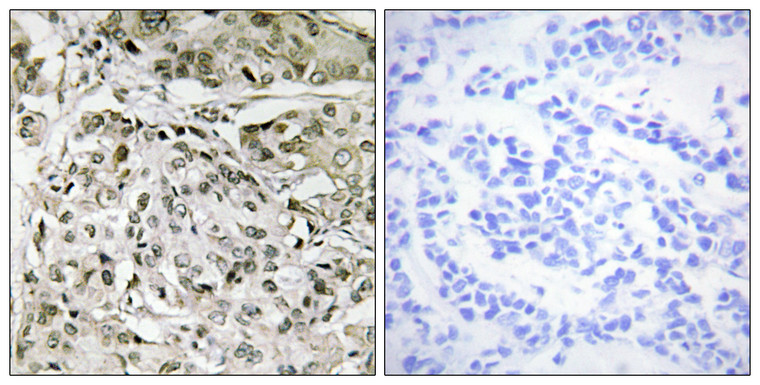| Host: |
Rabbit |
| Applications: |
IHC/IF/ELISA |
| Reactivity: |
Human/Mouse |
| Note: |
STRICTLY FOR FURTHER SCIENTIFIC RESEARCH USE ONLY (RUO). MUST NOT TO BE USED IN DIAGNOSTIC OR THERAPEUTIC APPLICATIONS. |
| Short Description: |
Rabbit polyclonal antibody anti-Transcription initiation factor TFIID subunit 1250 (1131-1180 aa) is suitable for use in Immunohistochemistry, Immunofluorescence and ELISA research applications. |
| Clonality: |
Polyclonal |
| Conjugation: |
Unconjugated |
| Isotype: |
IgG |
| Formulation: |
Liquid in PBS containing 50% Glycerol, 0.5% BSA and 0.02% Sodium Azide. |
| Purification: |
The antibody was affinity-purified from rabbit antiserum by affinity-chromatography using epitope-specific immunogen. |
| Concentration: |
1 mg/mL |
| Dilution Range: |
IHC 1:100-1:300ELISA 1:10000IF 1:50-200 |
| Storage Instruction: |
Store at-20°C for up to 1 year from the date of receipt, and avoid repeat freeze-thaw cycles. |
| Gene Symbol: |
TAF1 |
| Gene ID: |
6872 |
| Uniprot ID: |
TAF1_HUMAN |
| Immunogen Region: |
1131-1180 aa |
| Specificity: |
TAF II p250 Polyclonal Antibody detects endogenous levels of TAF II p250 protein. |
| Immunogen: |
The antiserum was produced against synthesized peptide derived from the human TAF1 at the amino acid range 1131-1180 |
| Function | The TFIID basal transcription factor complex plays a major role in the initiation of RNA polymerase II (Pol II)-dependent transcription. TFIID recognizes and binds promoters with or without a TATA box via its subunit TBP, a TATA-box-binding protein, and promotes assembly of the pre-initiation complex (PIC). The TFIID complex consists of TBP and TBP-associated factors (TAFs), including TAF1, TAF2, TAF3, TAF4, TAF5, TAF6, TAF7, TAF8, TAF9, TAF10, TAF11, TAF12 and TAF13. TAF1 is the largest component and core scaffold of the TFIID complex, involved in nucleating complex assembly. TAF1 forms a promoter DNA binding subcomplex of TFIID, together with TAF7 and TAF2. Contains novel N- and C-terminal Ser/Thr kinase domains which can autophosphorylate or transphosphorylate other transcription factors. Phosphorylates TP53 on 'Thr-55' which leads to MDM2-mediated degradation of TP53. Phosphorylates GTF2A1 and GTF2F1 on Ser residues. Possesses DNA-binding activity. Essential for progression of the G1 phase of the cell cycle. Exhibits histone acetyltransferase activity towards histones H3 and H4. |
| Protein Name | Transcription Initiation Factor Tfiid Subunit 1Cell Cycle Gene 1 ProteinTbp-Associated Factor 250 KdaP250Transcription Initiation Factor Tfiid 250 Kda SubunitTaf(Ii250Tafii-250Tafii250 |
| Database Links | Reactome: R-HSA-167161Reactome: R-HSA-167162Reactome: R-HSA-167172Reactome: R-HSA-674695Reactome: R-HSA-6804756Reactome: R-HSA-73776Reactome: R-HSA-73779Reactome: R-HSA-75953Reactome: R-HSA-76042 |
| Cellular Localisation | Nucleus |
| Alternative Antibody Names | Anti-Transcription Initiation Factor Tfiid Subunit 1 antibodyAnti-Cell Cycle Gene 1 Protein antibodyAnti-Tbp-Associated Factor 250 Kda antibodyAnti-P250 antibodyAnti-Transcription Initiation Factor Tfiid 250 Kda Subunit antibodyAnti-Taf(Ii250 antibodyAnti-Tafii-250 antibodyAnti-Tafii250 antibodyAnti-TAF1 antibodyAnti-BA2R antibodyAnti-CCG1 antibodyAnti-CCGS antibodyAnti-TAF2A antibody |
Information sourced from Uniprot.org
12 months for antibodies. 6 months for ELISA Kits. Please see website T&Cs for further guidance







